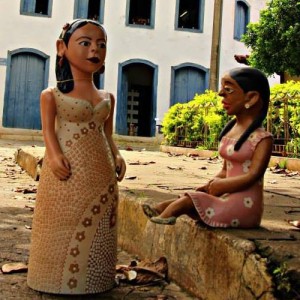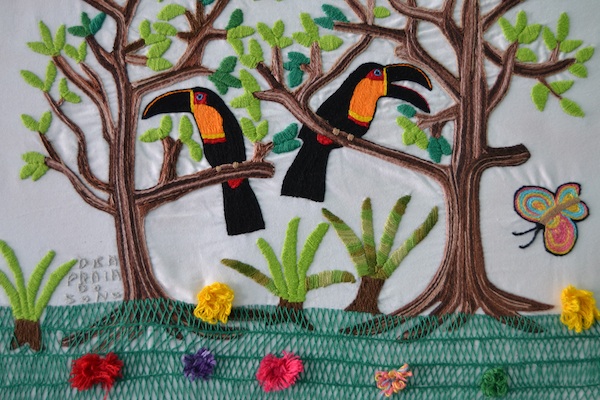As part of Gift Brazil’s Great Craft Tour, we visited Apiaí, a small town located 320km from São Paulo city surrounded by lush Atlantic rainforest and one of the most important and traditional pottery hubs in southeast Brazil. Apiaí wants to make its priviledged location and outdoor activities more known to tourists, that is not what we came for: we wanted to know more about the the pottery history in the town and the people making it, employing a mix of techniques inherited by indigenous tribes and African slaves. During the eighteenth century, the region surrounding Apiaí – also known as the Ribeira do Iguape Valley, or simply Rbeira Valley – was populated by former African slaves that had been freed or escaped their captivity. The fugitives then married local women and became farmers, who also produced their own clay pots, crockery and decorative objects. Way before the African slaves arrived,
Category: Blogging

Craft brings hope to Jequitinhonha Valley
There is a major stigma of poverty and serious social, economic and environmental problems in the Jequitinhonha Valley. But the region, despite all its difficulties, is also one of the richest of Brazil in terms of culture and craft production. Located in the northern state of Minas Gerais, the Valley is home to some 80 small towns that in the heyday of mining attracted immigrants from all over the country, after the wealth of mineral resources in the area, including gold and diamonds. Today, centuries after all the predatory mining that took place, the region suffers badly with lack of opportunities. The typical drought and blazing sunshine does not make things easier for the local families – husbands often have to seek farming work in other places during the dry season, which can last as long as eight months. Faced with the arduous job of looking after the home and
Caning unites craft and architecture in Brazil
We have already talked about the cobogó, the ever-present concrete feature created in Brazil back in the 1920s as a solution to ventilate rooms, nowadays a decorative item in its own right and available in many graphic variations. When we found an example where cobogó met caning, we loved it even more. São Paulo-based architect Cícero Ferraz da Cruz created a new type of cobogó inspired in the chair weaving patterns of caning resulted in a project that unites two elements full of Brazilian character. The cement pieces formed the beautiful panel of 5 x 6m seen above, now on display at Farm, a Brazilian womenswear chain, where caning was also used for the shop façade. Caning, a traditional type of chair-weaving craft deriving from peeled bark or skin of the rattan vine, is very commonly seen in Brazil as a main feature of chairs, tables, bed headboards and other items. The

The Arraiolo rugs of Diamantina
The Minas Gerais city of Diamantina was a center of European culture with a thriving economy during Brazil’s colonial period. Gold and diamonds attracted hordes of explorers from all parts of Brazil and beyond. However, once the mines were depleted, work opportunities were few and far between – similarly to what has happened in the nearby Jequitinhonha Valley. Also in Diamantina, craft played a very important role in the local economy. The wool rugs of Arraiolos, a small town in Portugal, are made with a needlework style that is inspired by Persian carpets, since the Middle Ages. But it wasn’t until quite recently that this craft style became known – and made – in Brazil. Known simply as “tapete arraiolo” in Brazil, the rug-making technique was introduced in the 1970s through to an initiative of the then archbishop of Diamantina, who sought to create work for the impoverished housewives of the region. Maria de Fátima

Craft, poverty and social change in Brazil
Brazil is a very unequal society. In big cities like São Paulo, it is possible to walk down a street filled with Chanel and Louis Vuitton shops that are more expensive than they are in Europe and then to turn a corner to find someone living in a shack built on the street. According to the World Bank, there are only 12 countries in the world that have a worse distribution of income. The World Bank uses a measurement called the Gini coefficient to measure income inequality – put simply, if every person in a country has the same income then the Gini would be 0 and if one person has all the cash then the Gini would be 1. The Gini coefficient is usually multiplied by one hundred so that it can be written as a percentage. So to give you an idea of the various scores, Denmark is the most

Brazilian fabrics bring warmth to your home
With its bold and bright colors and floral patterns, Brazilian fabric chita lends a very warm, summery feel to any decor scheme. We have already talked about chita here on Gift Brazil – the chita, which was only a “fabric of the masses” back in the day returned to the mainstream with full force in recent decades. The chita – or “chitão,” as it is also known – and is used not only in local craft items, but by also interior designers as part of a project with lots of Brazilian character and anyone looking to give a summery touch to their home decoration. To give you a feel of what it would look like in practice, we selected some amazing homely spaces where chita has taken a leading role – with so many bright colors around, how would it be possible to come home after a long day at work and
The basket weaver of Monte Alegre do Sul
“When I go out everyday, my husband thinks I am going to a meeting” As softly spoken basket weaver Santina Berlofa sits down to talk about her life-long love for handmade, her eyes sparkle and a broad smile lights up the 82 year-old artisan’s face. When I arrive for our meeting on a bright Sunday morning, Santina is actually working – she does the voluntary job of serving customers at the shop run by the artisan association of Monte Alegre do Sul, a small town in the countryside of São Paulo, every day. “I come here everyday to work, but my husband thinks I am going to attend a meeting of the association. He asks: ‘are they going to close the association?’ I tell him ‘it is not going to happen’ and he sighs in relief – we have that same conversation all the time,” she laughs. Santina has been

John Hudson’s guesthouse in Paraty, Rio de Janeir
When the subject is luxury accommodation, small inns or bed & breakfasts tend to be charming and highly personal, while big hotels offer everything a guest could want – but the places offering the best of both worlds are few and far between. For this very reason, John Hudson’s beautifully decorated pousada (inn) Vivenda has – for a few years now – been the winner of TripAdvisor’s Travellers Choice award for B&Bs and Inns in the small coastal town of Paraty, in Rio de Janeiro. A little oasis located a short walk away from the town, the place has a magical air of seclusion, privacy, and exclusivity that carries into the two pristine white bungalows and a suite inside the main house. Most prominent in these self-contained homes with dining area, fully equipped kitchen and porch is the Brazilian art and craft collection on the walls and spaces, curated by Vivenda’s owner himself, who also built

Rio beach paradise creates embroidery tradition
An hour’s walk through the jungle from the small Rio de Janeiro coastal town of Paraty, an amazingly beautiful and peaceful beach only shared with a few locals and surfers can be found. Far from everything and close to paradise, the Praia do Sono (Sleep Beach, in Portuguese) is home to less than 70 families, including many women who are now working to establish a tradition in embroidery. Supported by Sebrae, the Brazilian service of support for small enterprises, the group “Bordadeiras da Praia do Sono” (“The Embroiderers from Sleep Beach”, in a literal Portuguese translation) made their first foray into embroidery in 2007 with the intention of supplementing the income of their partners, mainly fishermen or builders working in the region. Since then, the embroidery work from this tiny village is now gaining popularity across Brazil for its rustic and original themes, which represent the everyday lives of coastal

Enabling digital inclusion in Brazil with craft
Digital inclusion is a topic really close to our heart at Gift Brazil. We believe that our project is not just about helping artisans to sell their products to the world, it also helps these people in remote locations to learn about the value that the Internet can introduce into their life. These people can enter the digitally included society with our help, but there are some strange things taking place in the digital world in Brazil at present. On Wednesday this week, the President of Brazil, Dilma Rousseff, signed a new bill into law that guarantees online privacy and equal access rights for Brazilian Internet users. Called the Marco Civil da Internet, (also known as the country’s “Internet Constitution”) this bill goes further, but is effectively a bill of rights for the public, setting out the way Internet Service Providers must behave and explicitly addressing questions around spying – this is